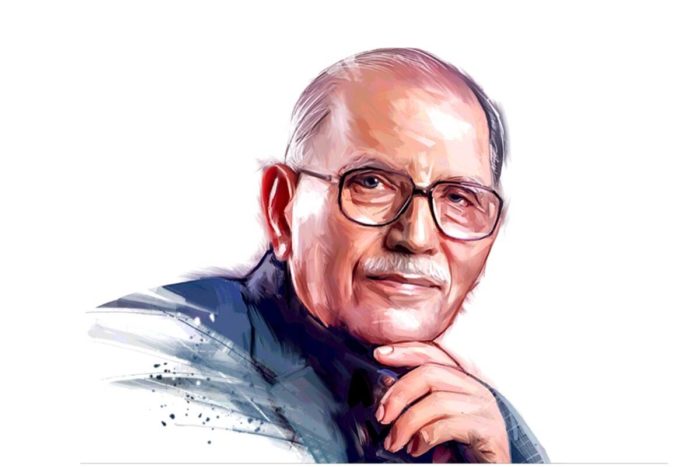In the remembrance of of Faqir Chand Kohli, the mind behind India’s IT Revolution.
In these days, the longest and chilliest time of animosity in recent decades, we Indians have recently read a heart-warming Peshawar news. We were delighted by Khyber Pakhtunkhwa’s government’s decision to preserve and renovate the ancestral homes of two proud sons of this historic city, Raj Kapoor and Dilip Kumar, the greatest stars of yesteryear in Bollywood.The heritage of Bollywood belongs, in certain fundamental respects, partially to Pakistan. Unfortunately, our country’s fanatical Hindutva forces are now trying to remove not only its ties to Pakistan, but also the Muslim contribution to its evolution and phenomenal global credibility.
More numerous are Lahore’s links that bind India and Pakistan. In Lahore, Nobel laureate physicist Subrahmanyan Chandrasekhar was born, and so was O P Nayyar, one of the greatest composers of Bollywood music. Another Nobel laureate, Hargobind Khorana, a physicist, studied at the famous Government College of Lahore, and so did Dev Anand, a beloved Bollywood hero. Names of many more could be recognized, and yet the list would be incomplete.
But how many Pakistanis, especially those from Peshawar and Lahore, have heard the name of Faqir Chand Kohli, the father of the information technology industry in India, who died at the ripe old age of 96 in Mumbai on November 26? Not many maybe. Pakistanis are really involved in the goings on of the film industry in India. But at a time when the IT industry in Pakistan and its young IT professionals are realizing their own tremendous potential for development, it may help to learn a little bit about the life and legacy of someone who was born and raised on their soil, made it big in India, and who, moreover, believed fervently in India-Pakistan peace, friendship and cooperation.
Tata Consultancy Services — bigger than IBM and Accenture
In1924, Kohli was born in Peshawar. His father, Gobindram Kohli, was a small businessman, the owner of the Peshawar Cantonment Kriparam Drapers. From Lahore’s Government College, he completed his BA and BSc (Honors). He came to Bombay in1951, after completing his masters in power engineering from the prestigious Massachusetts Institute of Technology (MIT) in the US to join the Tata Group, India’s most respected and diversified business conglomerate. There, he founded Tata Consultancy Services (TCS), now India’s largest and most valuable IT firm, with the help of the legendary JR D Tata. TCS, a jewel in the crown of the Tata Group, is one of the world’s largest market-capitalized IT services providers ($145 billion), bigger than IBM ($118 billion) and Accenture ($143 billion). Kohli was TCS’s first and longest serving CEO. Till the end, his affiliation with the Tata Party persisted. He was confined to his home in Mumum, until the coronavirus pandemic.
Mumbai and Karachi were among the best run cities in Asia prior to Partition, and also for some years after 1947. In this regard, a good part of the prestige of Mumbai was that the power supply utility of the town was run by the Tatas. A brilliant engineer whose career started with Tata Electric Companies, Kohli helped make it even better, almost as good as New York’s. He showed that the use of computers could significantly boost productivity and the integration of structures, which were then primitive compared to those today. But with computers, young Kohli wanted to do more. He was a visionary who foresaw that this groundbreaking new technology was the future. Fortunately for him and for India, this conviction was firmly held by J R D Tata, who headed the party from 1938 until his death in 1993 as its chairman. This conviction gave birth to TCS.
In the initial decades, Kohli faced enormous odds because it was a time when India’s political and governing elite had little knowledge of the disruptive ability of computers and computer software to provide solutions to large-scale problems. To make matters worse, due to a serious foreign exchange crunch triggered by a steep devaluation of the rupee at the behest of the World Bank in 1966-67, the government made it extremely difficult to import sophisticated computers from the West. “You will be permitted to import computers only if you can bring in more dollars from your exports,” private companies were told.
This did not stop Kohli, who “literally and metaphorically was a frontier,” reminds Shivanand Kanavi, who worked in TCS and wrote The Incredible Story of Digital Technology, Sand to Silicon. Having emerged from what was historically called the Province of the North West Frontier, the resilient Peshawari genes of Kohli prodded him to turn hardship into an opportunity. Kohli realized that by providing software solutions and services to large western companies, especially in the US, TCS could earn a lot of dollar sales for itself and a much-needed forex for India. Indian software engineers may work in Mumbai and other cities on imported computers, or offer their services to their customers in America on-site. For two reasons, this has been a win-win for both TCS and its offshore clients. One to meet the needs of its booming economy, America’s own native tech expertise was both costly and in short supply. Two, India began manufacturing large numbers of tops in the 1970s and 1980s-
A builder of institutions and leaders
The TCS model of export-led growth has rapidly become so popular and appealing that many Indian tech startups have been developed, some of which have become global icons. For instance, one of India’s most respected and profitable IT companies is Infosys, founded in 1981 by N R Narayana Murthy, Nandan Nilekani (both IITians and both among India’s most respected tech entrepreneurs) and five others. Azim Premji, India’s biggest philanthropist, has donated $16 billion of his personal wealth so far. Tech exports from India have skyrocketed from $8 billion in 2000 to $150 billion in 2020. The “Silicon Valley” of India came to be viewed as Bangalore, which attracted the largest number of Indian and foreign technology firms. The IT industry has also boomed in Pune, Hyderabad, Chennai, Mumbai and Delhi in other Indian cities. Tens of thousands of young IT professionals, both in India and abroad, have high-paying jobs. In some of the places, Indians rose to high positions.
TCS sprinted well ahead of its rivals in India. A big part of the reason for this was how under the mentorship of Kohli, the organization groomed a legion of excellent leaders.S Ramadorai, his successor as CEO, says: “I had the privilege of working with Kohli for 48 years. He was a brilliant technologist, great manager and a very good human being. He would throw very difficult challenges at us. But he also built competencies in TCS to meet those challenges.”
In his book The TCS Story and Beyond, Ramadorai describes how extremely tough the initial years were. “But somewhere deep down,” Kohli, he and their team “believed that we were not building a mere business but a new industry for India, and that was a dream worth working towards.”
N Chandrasekaran, who came after Ramadorai and was later made the chairman of the Tata Group in 2017 after Ratan Tata (nephew of J R D Tata) stepped down, says, “Kohli interviewed me when I joined TCS as a trainee. He was a leader with great clarity of thought and conviction. He saw very early on that IT services can be an industry in which India could build a core national strength.”
Many of his protégés have recalled that working under him was ‘Trial by Fire’. “If you crossed one fire, it meant he liked you and he would push you into a bigger fire.”
TCS was brought to much higher heights by both Ramadorai and Chandrasekaran than where Kohli had left it. One of the many reasons why the Tata Community is widely respected in India and abroad is this multi-generational continuity of excellent professional leadership. The most capable leaders were encouraged by both J R D Tata and Ratan Tata to head their community businesses. In western business conglomerates, this is yet another cultural characteristic that has matured.
Kohli worked relentlessly for the broad-based growth of India’s IT industry, not happy with the success of his own business alone. He did so by being one of the leaders of Nasscom and the Computer Society of India (National Association of Software and Service Companies). He was the driving force behind the IEEE (Institute of Electrical and Electronics Engineers) India branch, the technical engineers’ most influential global forum.
Kohli claimed that IT companies should consider themselves as problem solvers first and then as profit-making companies afterwards. Being an engineer at heart, he understood that engineering education, in its broadest sense, equipped students in business, economics and society to solve tough problems. India has faced a problem here. While IITs have gained a worldwide reputation, their student strength was and still is far less than the population and humorous needs of the country. He proposed a revolutionary concept, significantly raising the quality of a select number of promising engineering colleges and making them “IIT-like,” under a mentoring scheme with existing IITs, since setting up new IITs required enormous expenditure. At the College of Engineering in Pune, he actually introduced this concept. As the chairman of the Governor’s board, he said,
“When I was with the Observer Research Foundation (ORF) Mumbai, a leading Indian policy think tank, my colleague Dr Leena Wadia and we worked closely with Kohli — he was already in his 90s then — in producing an in-depth report on how CoEP was transformed into an IIT-like institution. India should transform, and India can indeed transform, 50 promising engineering colleges into IIT-like institutions.”
“India has no business being a nation of so many poor people”
With all these successes, Kohli was also nursing three great regrets. His insistent exhortation was to his friends and colleagues in industry and academia: “Our industry has benefited, but our industry has not benefited India much.” “We have to do more for India, a lot more. He was profoundly pained by the suffering of India. He would complain in many of my conversations with him, “India has no business being a nation of so many poor people.” He strongly believed that the combined force of technology and education will eliminate poverty and enrich the tremendous human resources of India. He piloted a major initiative for school dropout education, the reduction of illiteracy, and computer education in Indian languages.
Kohli was profoundly worried about the inability of India to grow its IT hardware industry, which stood in sharp contrast to its software industry’s shining performance. A keen follower of China’s technology developments, he was concerned about the widening IT hardware gap between India and China. India’s annual import bill for electronics, for instance, is around $60 billion. Of this, $20 billion goes to semiconductor chips, which are the digital economy’s backbone. While indigenous China generated only 16 percent of its semiconductor needs in2019, by 2025 it has set the target of generating 70 percent of China’s domestic semiconductor needs. In addition, China has promised $1.4 trillion worth of investment to build vital technologies by 2025. Kohli was therefore insistent on India being to a large extent, self-reliant in the manufacture of IT hardware.
Kohli’s other disappointment was that even in the field of IT there was basically no cooperation between India and Pakistan, so crucial for the all-round growth of any country. He was a witness of peaceful coexistence in both cities between Muslims, Hindus and Sikhs before Partition. His Peshawar roots made him proud. As revealed by one of his family members, “He had never felt discriminated against or insecure in Peshawar or Lahore. Partition affected him more than most know. As a matter of fact, the events made him who he was. His family went from affluence to abject poverty. When he returned from the US in 1951, he found his family (which had migrated to Lucknow) sleeping on the mud floor of a hutment.”
He sincerely wanted the normalisation of relations between India and Pakistan because of his own life experience. He dreamed of Pakistani students coming to India to study at our leading institutes of technology, including Indian students going to Lahore’s Punjab University and LUMS, and to all the other reputable institutions in Pakistan. Speaking at the first Pakistan-India ICT Summit in Islamabad on 16 December2004, when a memorandum of understanding to increase trade and cooperation was signed by Nasscom and the Pakistan Software Houses Association, he hoped that business and academic leaders would cooperate to bridge the digital divide across the border.
The principal reason for my penning this tribute to him in a Pakistani publication is this sorrow and this hope of his. I would like to express a few thoughts on what we can, at a modest level, do together for the consideration of those in Pakistan and also in India who share their regret and hope. Can we at least have a virtual meeting to celebrate his existence, because the strained political ties between our two governments do not permit any substantive joint activity? Can we create a chair at the Government College University in Lahore in Kohli’s memory? Can we launch scholarships for the bright technology students at Peshawar University in his name? Another thought: there is a fabulously popular E-Yantra’ project initiated by my friend Professor Kavi Arya in the computer science department at IIT Bombay, my own alma mater. It trains young robotics students in engineering. Kohli was a mentor of this project, in which similar (very low-cost) robotics laboratories were set up in
Similarly, shouldn’t we introduce Indian students to similar innovative projects in Pakistani institutions? Yet another thought: At MIT, Kohli’s alma mater, a large number of Indians and Pakistanis studied. Surely, in the field of engineering research and education, they can do something small but important. Even MIT would like to help a worthy initiative of this nature. Even MIT would like to help a worthy initiative of this nature. And maybe Nasscom and the Pakistan Software Houses Association should dust off the MoU they signed 16 years ago when wisdom returns and the chill decreases in India-Pakistan government-to-government relations, and think of ways to enforce it.
Author: Maavra Sajjad








